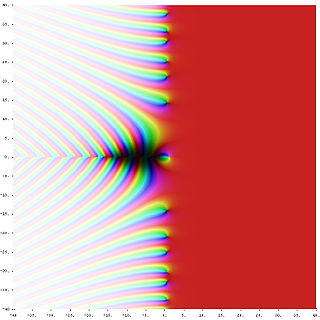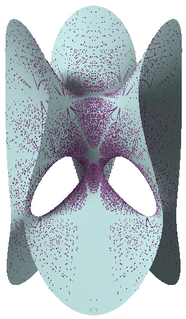In mathematics, a transcendental number is a real number or complex number that is not an algebraic number—that is, not a root of a nonzero polynomial equation with integer coefficients. The best-known transcendental numbers are π and e.
In mathematics, the Weil conjectures were some highly influential proposals by André Weil (1949), which led to a successful multi-decade program to prove them, in which many leading researchers developed the framework of modern algebraic geometry and number theory.

In mathematics, analytic number theory is a branch of number theory that uses methods from mathematical analysis to solve problems about the integers. It is often said to have begun with Peter Gustav Lejeune Dirichlet's 1837 introduction of Dirichlet L-functions to give the first proof of Dirichlet's theorem on arithmetic progressions. It is well known for its results on prime numbers and additive number theory.
In number theory, the study of Diophantine approximation deals with the approximation of real numbers by rational numbers. It is named after Diophantus of Alexandria.
In mathematics, the Littlewood conjecture is an open problem in Diophantine approximation, proposed by John Edensor Littlewood around 1930. It states that for any two real numbers α and β,
In mathematics, Roth's theorem is a fundamental result in diophantine approximation to algebraic numbers. It is of a qualitative type, stating that a given algebraic number may not have too many rational number approximations, that are 'very good'. Over half a century, the meaning of very good here was refined by a number of mathematicians, starting with Joseph Liouville in 1844 and continuing with work of Axel Thue (1909), Carl Ludwig Siegel (1921), Freeman Dyson (1947), and Klaus Roth (1955).
In mathematics, the Mahler measureof a polynomial with complex coefficients is defined as
Transcendental number theory is a branch of number theory that investigates transcendental numbers, in both qualitative and quantitative ways.
This is a glossary of arithmetic and diophantine geometry in mathematics, areas growing out of the traditional study of Diophantine equations to encompass large parts of number theory and algebraic geometry. Much of the theory is in the form of proposed conjectures, which can be related at various levels of generality.
A height function is a function that quantifies the complexity of mathematical objects. In Diophantine geometry, height functions quantify the size of solutions to Diophantine equations and are typically functions from a set of points on algebraic varieties to the real numbers.
In algebraic geometry, the Chow groups of an algebraic variety over any field are algebro-geometric analogs of the homology of a topological space. The elements of the Chow group are formed out of subvarieties in a similar way to how simplicial or cellular homology groups are formed out of subcomplexes. When the variety is smooth, the Chow groups can be interpreted as cohomology groups and have a multiplication called the intersection product. The Chow groups carry rich information about an algebraic variety, and they are correspondingly hard to compute in general.
In mathematics, the Gauss–Manin connection is a connection on a certain vector bundle over a base space S of a family of algebraic varieties Vs. The fibers of the vector bundle are the de Rham cohomology groups of the fibers Vs of the family. It was introduced by Manin (1958) for curves S and by Grothendieck (1966) in higher dimensions.
Lehmer's conjecture, also known as the Lehmer's Mahler measure problem, is a problem in number theory raised by Derrick Henry Lehmer. The conjecture asserts that there is an absolute constant such that every polynomial with integer coefficients satisfies one of the following properties:
In mathematics, Arakelov theory is an approach to Diophantine geometry, named for Suren Arakelov. It is used to study Diophantine equations in higher dimensions.
In mathematics, the Bogomolov conjecture, named for Fedor Bogomolov, is the following statement:
In transcendental number theory, a mathematical discipline, Baker's theorem gives a lower bound for the absolute value of linear combinations of logarithms of algebraic numbers. The result, proved by Alan Baker, subsumed many earlier results in transcendental number theory and solved a problem posed by Alexander Gelfond nearly fifteen years earlier. Baker used this to prove the transcendence of many numbers, to derive effective bounds for the solutions of some Diophantine equations, and to solve the class number problem of finding all imaginary quadratic fields with class number 1.
In mathematics, Vojta's conjecture is a conjecture introduced by Paul Vojta (1987) about heights of points on algebraic varieties over number fields. The conjecture was motivated by an analogy between diophantine approximation and Nevanlinna theory in complex analysis. It implies many other conjectures in Diophantine approximation, Diophantine equations, arithmetic geometry, and mathematical logic.
In mathematics, van der Corput's method generates estimates for exponential sums. The method applies two processes, the van der Corput processes A and B which relate the sums into simpler sums which are easier to estimate.

In mathematics, the Manin conjecture describes the conjectural distribution of rational points on an algebraic variety relative to a suitable height function. It was proposed by Yuri I. Manin and his collaborators in 1989 when they initiated a program with the aim of describing the distribution of rational points on suitable algebraic varieties.
Joseph Hillel Silverman is a professor of mathematics at Brown University. Joseph Silverman received an Sc.B. from Brown University in 1977 and a Ph.D. from Harvard University in 1982 under the direction of John Tate. He taught at M.I.T. (1982–1986) and at Boston University (1986–1988) before taking a position at Brown in 1988.
Graduate Texts in Mathematics (GTM) is a series of graduate-level textbooks in mathematics published by Springer-Verlag. The books in this series, like the other Springer-Verlag mathematics series, are yellow books of a standard size. The GTM series is easily identified by a white band at the top of the book.

The International Standard Book Number (ISBN) is a numeric commercial book identifier which is intended to be unique. Publishers purchase ISBNs from an affiliate of the International ISBN Agency.






